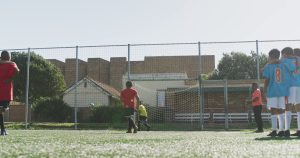By: Terra Price, MS, Ed.S
As parents, we often witness our children experiencing a “collapse” after school, known as after school restraint collapse. After school restraint collapse refers to the behavioral and emotional challenges experienced by children after holding themselves together during the school day. This phenomenon occurs when children, after maintaining self-control throughout the school day, release their pent-up emotions and energy once they feel safe at home. This can manifest as moodiness, whining, or meltdowns. It’s particularly common among children aged 12 and younger and is more prevalent in sensitive and intense kids, as well as those struggling with learning or socialization. Evidence suggests that children are more likely to experience this collapse if they have a demanding school environment, strong adherence to rules, or have to suppress their emotions throughout the day.
Understanding and managing after school restraint collapse can help create a smoother transition from school to home. In this article, we will explore this topic and provide practical tips to support your child through this period of emotional vulnerability.
 The Toll of After School Restraint Collapse
The Toll of After School Restraint Collapse
Emotional and Behavioral Signs
– Tantrums, meltdowns, or outbursts of anger.
– Increased irritability and emotional sensitivity.
– Fatigue and low energy levels.
– Withdrawal or increased need for solitude.
Academic and Social Challenges
– Difficulties with transitions or completing homework.
– Decreased ability to engage positively with family members.
– Struggles to manage social interactions or conflicts effectively.
Strategies for Promoting Emotional Regulation and Recovery
Creating a calm and predictable home environment is crucial for helping your child recover from after school restraint collapse and promote emotional regulation. Here are some evidence-based strategies:
Unwinding Activities
– Offer a healthy snack upon returning home to replenish energy levels.
– Encourage downtime and unstructured play to allow their minds to decompress.
– Engage in calming activities such as reading, listening to music, or drawing.
Physical Discharge Activities
– Promote physical activities like outdoor play, sports, or yoga.
– Engaging in movement can help release accumulated tension and promote positive mood changes.
– Encourage sufficient physical exercise throughout the day.
Consistent Routine and Predictability
– Establish a consistent after-school routine that includes a balance of activities and downtime.
– Clearly communicate expectations and schedules to provide a sense of predictability.
– Avoid overscheduling extracurricular activities, allowing for ample time for relaxation and self-care.
Emotional Validation and Communication
– Create a safe space for your child to express their feelings and concerns.
– Practice active listening, empathy, and validation to help them process their day’s experiences.
– Be authentic and share your own experiences of navigating emotions to foster a supportive atmosphere.
Collaboration with Teachers and Schools
Working in partnership with your child’s teacher and the school community is vital for addressing after school restraint collapse collectively. Consider the following strategies:
Open Communication
– Initiate open and regular communication with your child’s teacher to share insights and concerns about after school restraint collapse.
– Working together, you can explore strategies that support emotional well-being both at school and at home.
Advocacy for Balanced Expectations
– Advocate for the importance of a balanced approach to school expectations and student well-being.
– Discuss the potential impact of high demands on your child’s emotional state and suggest adjustments that prioritize their well-being.
Promote Emotional Supports at School
– Collaborate with the school to implement measures that support emotional regulation, such as mindfulness activities or quiet spaces for relaxation.
 Are Gifted and Neurodiverse Students More Susceptible?
Are Gifted and Neurodiverse Students More Susceptible?
Gifted and neurodiverse children may be more susceptible to after school restraint collapse due to various factors that impact their cognitive, emotional, and sensory experiences. However, it is important to note that not all gifted or neurodiverse children will experience after school restraint collapse, as each individual is unique and their experiences may differ. Here are some reasons why gifted and neurodiverse children may be more susceptible:
Intense Cognitive Processing
Gifted children often possess advanced cognitive abilities and may engage in deep, complex thinking throughout the day. This intensity can lead to mental fatigue and emotional exhaustion, particularly when compounded by additional stressors such as academic expectations.
Heightened Sensitivity
Neurodiverse children, such as those with autism, ADHD, or sensory processing differences, may experience sensory overload during the school day. Their heightened sensitivities to noise, light, or other environmental stimuli can lead to increased fatigue and difficulty regulating emotions after school
Perfectionism and High Expectations
Gifted children or those with certain neurodiverse traits may exhibit perfectionistic tendencies and place high expectations on themselves academically or socially. The pressure to meet or exceed these expectations can result in increased stress, anxiety, and subsequent emotional exhaustion.
Need for Decompression
Gifted and neurodiverse children often require time and space for decompression and processing after school. They may need an opportunity to unwind, engage in preferred activities, or simply have downtime to recharge their mental and emotional energy.
Social and Emotional Complexity
Gifted and neurodiverse children may grapple with social or emotional complexities that can be draining. Issues such as asynchronous development, feelings of isolation, or heightened empathy can contribute to emotional fatigue and a greater need for intentional self-care.
It’s crucial to remember that these factors do not solely determine a child’s susceptibility to after school restraint collapse. Each child’s experience is unique, and factors such as individual temperament, support systems, and external stressors can also play a role. It is essential to recognize and support the individual needs of each gifted or neurodiverse child to minimize the likelihood of after school restraint collapse and foster their overall well-being.
Understanding after school restraint collapse is key to helping children navigate the emotional challenges they may face after a demanding day at school. By implementing evidence-based strategies such as promoting emotional regulation, establishing consistent routines, fostering open communication, and collaborating with teachers and schools, you can create a supportive environment that nurtures your child’s emotional well-being. Remember, patience, empathy, and a collaborative approach between home and school can go a long way toward helping your child successfully cope, promoting a positive and balanced educational experience.
Resources
Smith, J., & Brown, K. (2020). After-School Restraint Collapse in Children with ADHD: A Case Study. Journal of Child and Adolescent Behavior, 8(3), 165-172.
Thompson, M. (2019). Understanding the Emotional Release Phenomenon in School-Aged Children. Journal of School Psychology, 75, 113-125.
Johnson, L., & Green, A. (2018). The Impact of School Environment on After-School Emotional Meltdowns. Child Development Research, 2018, Article ID 2345678.



